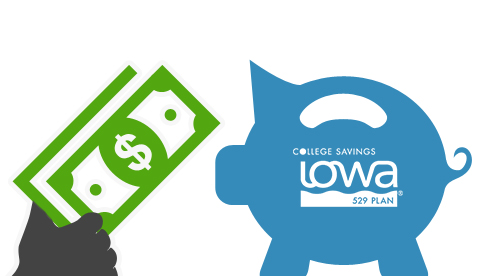Tax Benefits of the College Savings Iowa 529 Plan
Feb 22, 2024 By Triston Martin
College Savings Iowa is a 529 plan. Residents of Lowa who contribute to the plan are eligible for a tax credit from the state. It is accessible to individuals from any state, with cheap costs and fourteen investment options from Vanguard. College Savings Iowa was the state's first 529 plan. It was made in the year 1998. It is sold by people who help people get money. In 2006, the IAdvisor 529 Plan was put into place. It is sold straight to people in Iowa and all over the country. The ways to invest in each plan are different. Both are to help people put money away for college.
Withdrawals are not subject to taxation. The federal government will not tax money withdrawn from your College Savings Iowa 529 account to pay for eligible education expenses. Additionally, if you pay Iowa state income taxes, none of your withdrawals will be taxed. The idea that 529 plans can only be used to pay for educational expenses is one of the most common misunderstandings regarding these plans. You can communicate with educational institutions all around the state by forming a partnership with Iowa College Aid. It is helpful to highlight the numerous different applications for 529 plans.
Tax Benefits of the College Savings
If you live in Iowa and want to send a child to college, you should know about the two types of 529 college savings plans. These 529 accounts let the money grow without having to pay state income taxes on it. Also, there are no federal or state income taxes on withdrawals. Nothing is used to pay for qualified college costs. Also, taxpayers in Iowa can deduct up to $3,474 per beneficiary if they put money into a 529 plan. They can deduct it from their income for state tax purposes.
With these plans, family and friends can simultaneously help a child pay for college and get a tax break. They can also get a tax break if they do this. Money from a college plan is only used for certain costs. It includes tuition, enrollment, or attendance, as well as the certain cost of a student with special needs. The most money that can be saved for one person is $420,000.
Types of Iowa Plans

There are two kinds of 529 plans in Iowa. People make plans to help them save money for college. It includes two-year and four-year colleges, graduate programs, technical and vocational schools, and technical and trade schools. The names of Iowa plans come from the number of the Internal Revenue Service code section that lets states make them. For both plans, there are costs. There is no guarantee that it will pay off. The investments made in the plans could lose money.
College Savings Iowa 529 Plan
This is a 529 savings plan. It is under the supervision of Vanguard Group Inc. and is in charge of the Treasurer of the State of Iowa. There are four different ways to follow the plan based on age. It also considers the investors' level of risk tolerance and gives them ten portfolios to choose from. Here, investors can create their portfolios by choosing up to five funds. All plan portfolios put money into Vanguard mutual funds, but the portfolios themselves are not mutual funds. Those who buy into the plan are investors.
I-Advisor 529 Plan
Additionally, this is a 529 savings plan. The Voya Investment Management program is under the supervision of the Office of the Iowa State Treasurer. In spite of the fact that the plan's options appear to be mutual fund investments, they are not. You will be purchasing municipal securities if you select to invest in any of the plan's available options. The value of the options is directly proportional to the amount of capital that underpins them. Using this plan, you have the option of investing in a portfolio of funds that you put together or investing based on the age of the beneficiary. Those who sell money to those who need it are known as money brokers.
Lowa 529 Plan vs. Other Savings Accounts

The people who live in Iowa are debating whether or not they should put their money into an Iowa 529 plan or whether they should put it into another type of savings vehicle. It is obligatory to consider the potential cost savings related to a deduction on state income taxes. Even if the deduction is advantageous, it's conceivable that more is in need to offset the benefits of user accounts that aren't counted. This is something to keep in mind.
Required Eligibility
There is no condition that you live in the state. Participants must be at least 18 years old and either citizens or permanent residents of the United States. The UGMA and UTMA custodian is also invited to participate. The program does not place substantial time limits or age requirements on its participants.
Contributions made by citizens of Iowa to a state-sponsored 529 college savings plan qualify for a tax deduction. The contributions to a 529 plan are eligible for a tax deduction when computing the state's taxable income, and contributions to the plan grow free of federal and state taxes. The money is not counted as taxable income when the withdrawal is put toward eligible higher education costs. You are free to contribute any amount you see fit. Additionally, at any frequency you choose.
Main Contributions
Contribution is made up to the maximum amount until the aggregate balance of all accounts held in Iowa's 529 plans for the same beneficiary exceeds $420,000. It is made until the end of the academic year. At the same time, the minimum payment is $25, or $15 per pay period, if it is automatically withdrawn from your paycheck. Alternatively, the minimal contribution is made manually. This plan has a full gifting platform that provides contributors with the ability to save their profile information for future contributions, including recurring payments.
Investment Options
Customer has the following investment options:
- Age-based/Enrollment Year investment options
- Static investment options
- Underlying investments

Important Considerations How to Understand a Balance Sheet
The accounting equation specifies that a company's total assets equal its total liabilities plus its owners' equity, thus it's important to grasp the various forms of assets, shareholders' equity, and liabilities to interpret the balance sheet properly. Unsurprisingly, revenue and cost recognition problems that show up on the income statement are intimately connected to the measurement problems on the balance sheet.
Jan 19, 2024 Triston Martin

Online Brokers for Free Stock Trading
Choosing the right online broker for free stock trading requires careful consideration of several factors. It's essential to review the charges, the trading platform, the security measures, and the investment options offered by the broker. By comparing your options and making an informed decision, you can find the right online broker to help you reach your investment goals
Oct 05, 2023 Triston Martin

How Long Does it Take for a Check to Clear?
Even though a check could clear the exact day it is deposited, it is much more common for the whole amount to be accessible after two working days or more. Some parts of check deposits are governed by federal law, while others are left to the discretion of the issuing and receiving financial institutions. Size, kind, issuer, deposit method, and bank/credit union restrictions all have a role in how quickly deposited money becomes available to you after making a deposit.
Feb 15, 2024 Triston Martin

What Are the Benefits of Good Credit?
If a borrower has good credit, it means they have a high credit score and are not a significant risk to lenders. Credit bureaus are the ones that hand out the scores. Lenders use credit scores to make underwriting decisions and disclose information found in a consumer's credit report.
Jan 11, 2024 Triston Martin

Top Peer to Peer Payment Apps
Because of the growing number of phones on the market today, peer-to-peer payments applications account for a significant portion of the digital payments industry. P2P applications, in their most basic form, allow for the frictionless movement of cash between two users. If you have ever divided a bill at a restaurant and paid the difference using a digital platform, you have certainly taken part in a peer-to-peer payment.
Dec 28, 2023 Triston Martin

Difference between Estimated Taxes and Estimated Tax Penalty
A quarterly payment of taxes for the whole year based on the filer's stated income for the period is estimated tax payment. Owners of small businesses, freelancers, and independent contractors make up most individuals who are obliged to make quarterly tax payments.
Dec 14, 2023 Triston Martin